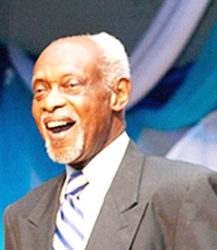Several Guyanese plays of historic significance were recently staged at the Theatre Guild and National Cultural Centre as part of a Jubilee festival. While there was nothing, whether in theme or form, that meaningfully brought these works together, there was something of interest in the history of some of them that place them interestingly in Guyanese drama.
![]() Foremost among them was the play that brought the curtains down on the long series – Journey to Freedom by Francis Quamina Farrier, directed by Godfrey Naughton at the National Cultural Centre. It is a play with some historical importance, brought back after more than 25 years and converted into a musical by Naughton. The play, which has its strengths and weaknesses as a script, made a statement as a play to celebrate Guyanese Independence. The production had humour, was strong in some areas, especially since it was generally well acted, but encountered glitches in a number of areas in executing the director’s vision, and it failed as a musical.
Foremost among them was the play that brought the curtains down on the long series – Journey to Freedom by Francis Quamina Farrier, directed by Godfrey Naughton at the National Cultural Centre. It is a play with some historical importance, brought back after more than 25 years and converted into a musical by Naughton. The play, which has its strengths and weaknesses as a script, made a statement as a play to celebrate Guyanese Independence. The production had humour, was strong in some areas, especially since it was generally well acted, but encountered glitches in a number of areas in executing the director’s vision, and it failed as a musical.
It was the last of the productions with historical or other significance, and the second one directed by Naughton. The first was House of Pressure written by the late Ian Valz. This play was derived from Moliere’s comedy The Miser, one of the classics of French drama and was staged by Valz at a very significant juncture in Guyanese theatre. It was that period after 1980 when there was an upsurge in local plays and the explosion of local popular theatre at the National Cultural Centre. Leon Saul (now known as Ras Leon Saul) staged his first play—For Better For Worse—at the Cultural Centre in 1981, as a leading contributor to an important development in the local stage. Valz was among those who followed him from the Theatre Guild to commercial theatre at the NCC, with House of Pressure.

Another was Black Bush by Sheik Sadeek and directed by Errol Chan, one of the plays that actually pioneered the rise of modern Guyanese drama in the 1960s. Sharing that pioneering role was the most successful and widely acclaimed play to come out of British Guiana at that time; a play that joined the top flight of foremost comedies in the Caribbean. That play was Miriamy written by Frank Pilgrim and directed by Ron Robinson. It is on the list of the most demanded Guyanese comedies, and certainly the oldest of them.
Also redone was Ronald Hollingsworth’s Till Ah Find A Place, directed by Sheron Cadogan, which holds the distinction as the most popular comedy, several times brought back as a box office hit. Joining it in that league was Paloma Mohamed’s Benjie Darling directed by Rae Wiltshire. Another of the oldest plays on the list was Come Back to Melda by John Campbell, which belongs to a tradition started by the backyard plays of the mid-twentieth century.
Journey to Freedom counts among those with significant background, in addition to being one of the older plays in the series. Its historical significance rests on two pillars. It is drawn from the corpus of one of the dramatists who drove the emergence of modern Guyanese drama in the 1960s, working mainly out of the Theatre Guild. Farrier followed both Pilgrim and Sadeek in this respect and was very prolific as a playwright with the likes of The Plight of the Wright. He was also a leading prize-winning actor. It was a period seen as the golden age of theatre in Guyana but it was dominated by foreign plays. Incidentally, foreign plays became even more popular among the new mass audiences in the 1980s at the NCC. So that playwrights like Sadeek, Pilgrim and Farrier in the sixties led the first significant impact with the substantial creation of local plays since Norman Cameron broke the ground in 1931.
The second pillar is the plot and patriotic national interests of the play itself. It focuses an important historical period in Guyanese history – the passage from colony to Independent nation, and was thus an appropriate play to bring back as a part of the crowded and extended celebration of the country’s 50th Anniversary of Independence. Farrier was obviously showing a people long accustomed to colonisation slowly being brought to the realisation that they would have to work for new status, change mentalities and old habits, including servitude to colonial masters and their successors. It showed a people struggling to liberate themselves.
In this respect the acting was mainly good with some characters who were the successes of both the plot and the performance. Prominent among those was Nicholas Singh who played a soldier with pride and patriotism who was a very positive influence in the liberation of his neighbours. Farrier’s intentions here were obvious and over-telegraphed with the soldier’s ‘heroic’ musings about the (topical) Rupunnuni Uprising, which however, thereafter played no role in the plot. Nevertheless the soldier’s role worked and was well played by Singh – one of the outstanding actors in the production.
Another in this regard was Akbar Singh as a youth struggling against poverty seduced into crime until the soldier succeeded in steering him to a different path to liberation. He joined the National Service (again obviously topical and patriotic) and made a success of his life, and this role was very sensitively and effectively played by Singh (Akbar). It told us he is capable of handling major acting roles. Thematically also the role worked, since the reformed young man seemed rewarded by marriage to the belle in the yard very credibly played by Abigail Brower. This marriage gave the play a surprise ending which fit the general theme of success, achievement and liberation but was somewhat mysterious since even after her engagement the girl still seemed smitten, in love with and pursuing the yard’s notorious, philandering womaniser Edwin (Johann David). Her surprising choice gave the play a twist and satisfactory ending but how she made the transition was not made logical by the script. The wedding’s kwe kwe sequence seemed a bit derivative, recalling Subraj Singh’s play Kwe Kwe done by the National Drama Company.
Both Nirmala Narine and Nelan Benjamin were sensitive and studied, standing out in performance. There was a host of good portrayals by Sonia Yarde, Frederick Minty, Taneka Caldeira, Alicia Charles and Brian Goodman. Both Goodman and Kijana Lewis (who overacted significantly) represented another of Farrier’s patriotic bullet points – the wealth of the interior and the career of gold and diamond seekers in a nation with the resources for freedom.
Naughton played this drama out on a very good set that worked for the play and confirmed it as social realism. He managed the comedy in a number of scenes very well, as well as some of the crowd scenes and choruses, and read the play correctly as one brimming with patriotism and a sense of nationhood. He converted it into a musical and this interpretation led him to choose Guyanese patriotic songs to carry that off.
While the production was competent in most of its areas, as a musical it didn’t work, and the attempt to play it as one led to some flaws. It seemed that songs were superimposed upon the play with insufficient time to perfect it. After a while one grew tired of the predictable songs of national praise and motivation which only worked in a few instances. For example the closing song by Kimberly Samuels fitted in and flowed with the drama and was so excellently performed. The best sequence of these songs was one done by the students of the National School of Theatre Arts and Drama (who served as a chorus line) doing Bill Pilgrim’s “Let’s Cooperate for Guyana” – that one worked while others did not.
This business of slotting in songs that did not emerge out of the plot, drama or characters led to awkward situations such as the sudden appearance of Guyana’s master baritone David Dewar on stage, obviously not a character in the play, standing conspicuously and uncomfortably around waiting for his cue to sing. One of the few occasions when the imposition of these songs worked was the dirge at the death of the pick-pocket (or choke and rob artist) played by Benjamin. It was a song done by the murdered thief’s sister, that commented chorally on the plot and character in a way most others did not, and accompanied by a dance by Tristana Roberts – quite well performed but obviously superimposed.
What was most jarring about this, however, was that the play did what musicals do – provided a live band playing in the orchestra pit and much credit is due for this. But, astonishingly, after going to such lengths to have this, the actress, Shevon Henry, sang from a recorded sound track! What is more, that was not the only occasion when recorded music was used in spite of the live band being there. So the production gave the local audience the rare treat of what a musical looks like on stage and then drastically reduced that experience.
Those shortfalls seemed the result of a production not having enough time to properly execute the director’s concept.





